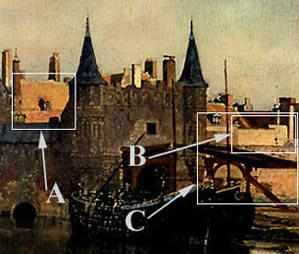Apart from shared membership of the human race, my father had but one thing in common with Marcel Proust – a fascination with that endlessly absorbing painting, A View of Delft by Jan Vermeer (born on this day in 1632). He – my father, that is – saw it in the Hague some time in the early Sixties and was so impressed that he bought a reproduction of it, which hung in our breakfast room, and in my parents' subsequent homes, for years. It certainly played a major part in my awakening to the power of art.
Proust saw the View of Delft at the Jeu de Paume in May 1921, in a loan exhibition of Dutch paintings. This shaky excursion from his apartment proved to be his last. It began with a severe attack of dizziness before Proust had even made it down the stairs, but, supported by his friend Vaudoyer, he soldiered on and made it to the Jeu de Paume, where he tottered up to the View of Delft and, after spending a while in contemplation, found himself sufficiently revived to move on to a concurrent Ingres exhibition and lunch at the Ritz before making his way home, still, according to Vaudoyer, 'shaken and alarmed'.
In The Captive, the last volume of A La Recherche, Proust transfers his Vermeer experience to the writer Bergotte, who, sleepless and ill, ventures out from his home to see the View of Delft on display. Like Proust, he is initially overcome by dizziness, but presses on determinedly. He has read a review of the exhibition that mentions a 'little patch of yellow wall' in the painting that is like 'a priceless specimen of Chinese art, of a beauty that was sufficient in itself'. Bergotte, who thought he knew every inch of the painting, cannot call to mind that little patch – until, in the gallery, he sees it, and with his discovery of it comes the realisation that 'That's how I ought to have written. My last books are too dry, I ought to have gone over them with a few layers of colour, made my language precious in itself, like this little patch of yellow wall.' Overcome with dizziness again, Bergotte slumps onto a circular settee, from which he shortly rolls unconscious onto the floor, while attendants and visitors rush from all corners to attend to him. He is dead.
Ever since Proust, there has been much argument over the whereabouts of that 'little patch of yellow wall' on Vermeer's painting. There are three contenders (see above), all in the sunlit area to the right of the picture – but none of this matters; there is more than enough to gaze – and wonder – at in the View of Delft.
Subscribe to:
Post Comments (Atom)


Thank you. This "little patch of yellow wall" comes up in Laura Cumming's Thunderclap. You'd like her interpretation of the yellow patch, and her appreciation of Vermeer and other Dutch artists. You and she are kindred spirits, I suspect.
ReplyDeleteThank you, Anon. Yes, several people have recommended Thunderclap to me, and I might well read it when it gets cheaper (or ideally turns up in a charity bookshop). Laura Cumming crossed my path years ago, and we didn't seem like kindred spirits then, but who knows what changes time might have wrought?
ReplyDelete